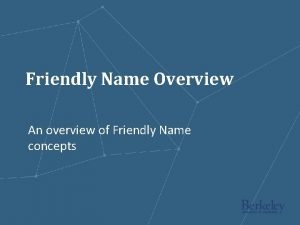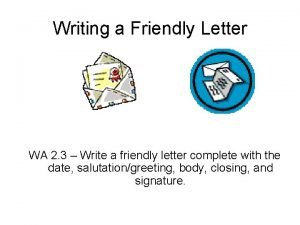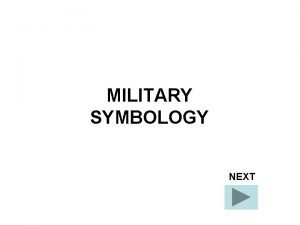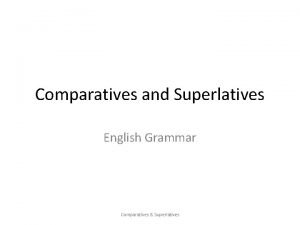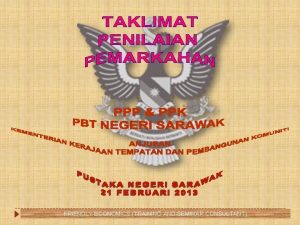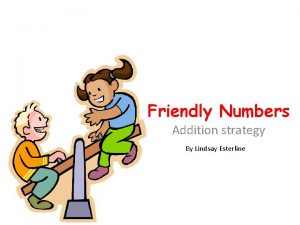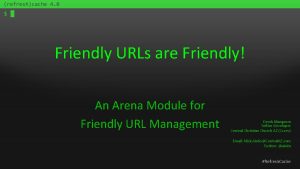Friendly Name Overview An overview of Friendly Name




















- Slides: 20

Friendly Name Overview An overview of Friendly Name concepts

What are Cal. Time Friendly Names? § The Problem: How does an employee know where to clock and log hours in Cal. Time, if the employee has multiple jobs or chartstrings (and that may need different approvals)? § The Solution: Cal. Time Friendly Names (FN) help non-exempt employees choose which appointment and/or chartstrings they will charge their hours to in Cal. Time. Without Friendly Names, employees with multiple jobs or who have multiple funding sources would not clearly be able to see which jobs or funding sources to pick in Cal. Time. 2

How are Friendly Names Used? • Friendly Names will display in Cal. Time for non-exempt employees to choose and track hours worked to the correct job or chartstring. This is particularly important for employees who have multiple jobs or chartstrings that need different approvals. • Friendly Names allow supervisors and/or “fund approvers” of non-exempt employees with multiple ”fund approvers” to review hours and approve only the hours the employee worked for them that are charged to particular grants, projects, other funding sources. • Friendly Names can be created to support reporting to identify number of hours worked by: – appointment – chartstring – location – project – event • Friendly Names are a field in HCM. It will download into Cal. Time, and employees who are Type C or S select which Friendly Name to charge their hours to. 3

Non-Exempt Employee’s Timecard Example of Friendly Names on a timecard in Cal. Time. The Friendly Name appears in the Transfer column. This drop-down field allows the employee to select which job or chartstring to add their hours. AZCSS-7397 U-0 CSS-Service. Now AZCSS-7397 U-0 4

Roles and Responsibilities for Friendly Names – CSS specific Friendly Names need to be created by a local department team who can identify which Friendly Name type should be associated with each appointment or chartstring. This process may differ for departments who have not joined Shared Services or who maintain different process. Responsible Party Task Local Department Team Creates Friendly Names for department and submits Friendly Name information to appropriate party (CSS or non-CSS HCM users Service Delivery (including HR Partners, HR Generalists, and First Contact Resolution Team) Works as liaison between department and HRIM team and Payroll & Timekeeping team HRIM Team or applicable CSS HR/APS HCM Administrator Enters and updates Friendly Names in HCM Payroll & Timekeeping Team Audits Friendly Names in Cal. Time 5

Friendly Name Types (1 of 3) There are three types of Friendly Names. Types A, C, and S. Friendly Names are chosen depending on the department’s needs and funding method. • Type A = Appointment. Type A Friendly Name is recorded at the Appointment/Job Level. Pay for the job is generated based on the existing Chartstring percentages entered. This is similar to how pay was processed before Cal. Time. • The majority of departments will use Type A FNs. 6

Friendly Name Types (2 of 3) • Type C = Chartstring. Type C requires a Friendly Name to be recorded for each Chartstring. The Friendly Names are used by the employee on their timecard to identify which projects or tasks they should be paid for. Payroll will use this information to calculate pay determined by hours recorded to each Chartstring on the timecard. Type C also allows a different “approver” to be added for each Chartstring. • Departments that use Type C FNs include departments and academic groups with multiple funding sources or projects. 7

Friendly Name Types (3 of 3) • Type S = Special Location. Type S is used by a few departments to create a hybrid of Type A Friendly Name + specific location/project. These pre-defined locations and projects are kept in a table in HCM. • Departments that use Type S FNs are UCPD, RSSP, Cal Performances, Intercollegiate Athletics, and possibly Rec Sports. 8

Creating Friendly Names Friendly Name Default • Default Friendly Name in HCM is Type A • Combination of: • Job Department Code (e. g. , AZCSS) • Job/Title Code (e. g. , 4921 U) • HCM Employee Record # Ø Dept. Code-Job. Code-HCMRecord# • Examples: • EAEDU-4921 U-0 School of Education, Student Asst 2 • AZCSS-7397 U-0 Campus Shared Services, HR Analyst 2 Entering/Editing Friendly Names • 20 character limit, combination of alphanumeric characters, hyphens, and/or spaces • While Type A can be left with the default Friendly Name, Type C requires the HCM user to manually enter or select a Friendly Name. 9

Standard Department Identifiers A Standard Department Identifer (a. k. a the “unique identifier”) was developed in order for employees to more easily choose the appropriate Friendly Name on their timesheet. For instance, it is easier for an employee to identify the department as “UHS” rather than by the department org ID “FYUHS” in the default friendly name. Therefore, departments were given the opportunity through the LILs to create a standard department identifier for their department. Whenever a FN is edited or added to the setup table, the FN must begin with the unique identifier for that department. Example: For Campus Shared Services HR/APS, the FN for the Benefits Analyst 2 in the Benefits team defaults to AZCSS 7719 U-0. When the FN is customized to CSS-HR-BENEFITS, the standard department identifier that is used is CSS. Using this method, an employee can quickly identify that CSS-HR-BENEFITS is the appropriate Friendly Name for them. 10

Friendly Name Setup Tables Default Friendly Names can be added to setup (or lookup) tables to make them easier to enter and to reduce data entry errors. • • • Friendly Names can be created as “on the fly” or added to the HCM lookup tables. Once a FN is loaded into the HCM lookup tables, they are available for assigning to appointments. The lookup will be based on an employee’s department and job code. Once a name or is added to the lookup table, it cannot be deleted. However, it can be inactivated by adding a row and an effective date. Default Friendly Names are not added to the table. Per the image below, different setup tables apply to different Friendly Name Types. 11

Friendly Names on a Timecard Example of Friendly Names on a timecard in Cal. Time. The Friendly Name appears in the Transfer column. This drop-down field allows the employee to select which job or chartstring to add their hours. AZCSS-7397 U-0 CSS-Service. Now AZCSS-7397 U-0 12

Friendly Name Caveats Idiosyncrasies and known issues with Friendly Names

Type A: CT PPS Flag (1 of 3) The CT PPS Flag check box was created to provide a solution to a business need that was previously hindered by a PPS interface issue. The Problem: Departments sometimes need to pay employees on more than 9 earnings distributions. However, although HCM can handle more than 9 earnings distributions, PPS can sometimes have problems with this. When there are too many earnings distributions, an appointment may not pass to PPS! How do we deal with this? The Solution: Cal. Time can pay on the 9+ distributions, so long as PPS holds the appointment (job code and salary) information. In order to ensure that the appointment information passes to PPS properly, we need to select 9 or less distributions. The CT PPS Flag check box was designed to allow the client and HCM administrator to select which of these earnings distributions will pass to PPS. 14

CT PPS Flag (2 of 3) Systems Flow • Although only 9 distributions will pass to PPS, all the distribution lines will pass to Cal. Time then passes all distributions as a file submission in a “batch process” to PPS. • PPS pays on all the distributions through this method. This payment record is kept in PPS and in the General Ledger. • The CT PPS Flag check box does not exist on exempt employees or for Type S Friendly Names. HCM Feeds appointment information and all 9+ distributions to Cal. Time HCM Feeds appointment information and 9 or less distributions (as selected by CT PPS Flag check box) to PPS Cal. Time Sends all 9+ earnings distribution as file submission to PPS Takes HCM appointment information and Cal. Time earnings file submission and pays employee 15

CT PPS Flag (3 of 3) Distribution Sample Flow PPS HCM Earnings Distribution 1* Earnings Distribution 2 Earnings Distribution 3* Earnings Distribution 4* Earnings Distribution 5* Earnings Distribution 6* Earnings Distribution 7* Earnings Distribution 8* Earnings Distribution 9* Earnings Distribution 10* Earnings Distribution 11 Earnings Distribution 12 Earnings Distribution 13 Earnings Distribution 14 Earnings Distribution 15 * Indicates chartstrings selected using CT PPS Flag. Earnings Distribution 1* Earnings Distribution 3* Earnings Distribution 4* Earnings Distribution 5* Earnings Distribution 6* Earnings Distribution 7* Earnings Distribution 8* Earnings Distribution 9* Earnings Distribution 10* Cal. Time Earnings Distribution 1* Earnings Distribution 2 Earnings Distribution 3* Earnings Distribution 4* Earnings Distribution 5* Earnings Distribution 6* Earnings Distribution 7* Earnings Distribution 8* Earnings Distribution 9* Earnings Distribution 10* Earnings Distribution 11 Earnings Distribution 12 Earnings Distribution 13 Earnings Distribution 14 Earnings Distribution 15 16

Supervisor vs. Delegate vs. Approver Within the context of Cal. Time, the term “supervisor” does not always indicate the employee’s true supervisor or even the supervisor of record in HCM. Term Supervisor Usage 1. 2. The supervisor of record in HCM or the employee’s actual supervisor. (Type C appointments only) Individual who is responsible for approving timesheets according to chartstring from “CT Supv ID” field. Sometimes called Approver. Example 1. 2. 3. Suzy Supervisor is the supervisor of record for Eli Employee. Sarah Supervisor is responsible for approving time charged to a specific chartstring; while she is a supervisor, she is not the employee’s actual supervisor. Erin Employee is responsible for approving time charged to a specific chartstring but is not the actual supervisor. Approver (Type C appointments only) Individual who is responsible for approving timesheets according to chartstring from “CT Supv ID” field. Erica Employee is responsible for approving time charged to a specific chartstring but is not the actual supervisor. Delegate Is an individual who has the responsibility of approving timesheets on behalf of a supervisor. 1. 2. Suzy Supervisor is on leave and delegates responsibility of approving timesheets to Daisy Delegate. Professor Peter is too busy to approve timesheets and delegates responsibility of approving timesheets to Dave Delegate. 17

Type C Supervisor Caveats Issue 1 – Adding Rows to Type C Employees • Problem: The “supervisor” listed in the CT Supv ID field will default back to the supervisor of record in HCM, if a new row is added. • Solution: Check the previous record and make sure that any “supervisors” listed in the CT Supv ID field matches the chartstrings on the current row. If appropriate to the action type, ensure that the correct “supervisor(s)” is listed in the CT Supv ID field. Issue 2 – Approvers Getting Access to Timesheets • Problem: If the “supervisor” listed in the CT Supv ID field is not already a supervisor of record in HCM, they will not automatically be granted access in Cal. Time to approve timesheets. • Solution: Submit a ticket to the Cal. Time Systems Administrator requesting access for the approver. 18

Retroactive Actions Friendly Names fields were added in HCM on 9/1/2014. However, if you look at previous records prior to 9/1/14, the Friendly Name field appears along with a Cal Time Type Code of Y. Cal Time Type Code Y is used as a placeholder for the Cal Time Type Code field for records prior to the 9/1/2014 conversion. It is not a valid value and cannot be selected by an HCM administrator. If the appointment requires you to add a Friendly Name type to the appointment for retroactive actions prior to 9/1/14, use Cal Time Code A and the default Friendly Name as a place holder so that you may save your record. 19

Resources Resource Location Friendly Name Job Aids http: //hrweb. berkeley. edu/hcm/wfa/step/friendly-names CSS Knowledge Base https: //kb. berkeley. edu/csshraps/internal/ Cal. Time Information http: //caltime. berkeley. edu 20
 Caltime access
Caltime access Opposite rays
Opposite rays What is a friendly letter?
What is a friendly letter? Letter writing process
Letter writing process Heading of a friendly letter
Heading of a friendly letter Friendly takeover
Friendly takeover The friendly giant story
The friendly giant story Amendment mun
Amendment mun On old olympus towering tops a friendly viking
On old olympus towering tops a friendly viking The man wasn't friendly. i spoke to him yesterday
The man wasn't friendly. i spoke to him yesterday Friendly nation 4 letters
Friendly nation 4 letters Enemy mechanized infantry section symbol
Enemy mechanized infantry section symbol Reverse acquisition
Reverse acquisition Persuasive letter techniques
Persuasive letter techniques What is a verb kid friendly definition
What is a verb kid friendly definition How to make friendly letter
How to make friendly letter Tom catania
Tom catania Features of friendly letter
Features of friendly letter Comparative well
Comparative well Thank you name with comma
Thank you name with comma Pgd
Pgd
